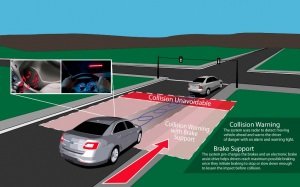 Ford is working on a technology that will enable cars to talk to each other, helping to reduce crashes as well as potentially fuel consumption. The technology, which Ford’s Director of Electrical and Electronics Systems, Jim Buczkowski, told us won’t be available for at least another 5 years or so, is based on a souped up form of Wi-Fi and GPS.
Ford is working on a technology that will enable cars to talk to each other, helping to reduce crashes as well as potentially fuel consumption. The technology, which Ford’s Director of Electrical and Electronics Systems, Jim Buczkowski, told us won’t be available for at least another 5 years or so, is based on a souped up form of Wi-Fi and GPS.
I participated in a demo of the talking car tech at an event organized by Ford at ATT Park in San Francisco on Wednesday. Using three Ford cars that have the WiFi/GPS system installed, the Ford drivers showed different scenarios where drivers can be alerted to potential safety hazards using loud noises and red flashing lights. For example, a car driving in a driver’s blindspot when the driver wants to turn into the impacted lane set off the alert system, as did a car suddenly pulling out in front of a driver at an intersection. (Note: It was a pretty fun demo as the three cars had to drive at fast enough speeds to simulate near accidents.)
The idea is that the wireless network and GPS chip in the cars can “see” the other cars connected to the network, even if the driver can’t actually see the other cars for one reason or another (they’re blocked at an intersection or in a blindspot). Ford is using a form of Wi-Fi called 802.11 p, which is Wi-Fi for driving environments, for the vehicle-to-vehicle talking tech and Ford is working with the Department of Transportation on the wireless standard.
The vehicle-to-vehicle technology is another step beyond what Ford is already doing with wireless technology within the car using bluetooth, as well as using wireless connections and mobile apps to provide Ford cars with connected infotainment and navigation systems. In particular for Ford’s upcoming electric vehicle the company is building a mobile app to help EV drivers find the nearest electric vehicle charging station.
Reducing accidents on the roads can lead to less congestion and more fuel efficient driving. The same vehicle to vehicle wireless technology can also be used to reduce overall congestion via other applications and congestion management tools that can use the knowledge of vehicle location and traffic conditions to suggest alternative routes or tweak driving habits. Singapore has a famous high-tech congestion management system.
Ford’s car talking tech is still in a prototype stage, but I think teaching people to respond in a productive manner to the flashing lights and loud noise, might prove a challenge. Another question up for debate, is who will pay for the added cost of the service and network connection to the car? Will the car owner be willing to buy the extra service, or will Ford have to add in the service for free and offset it with other methods of monetization. During a panel of speakers at the Ford event, ATT’s Vice President for Emerging Devices, Win Williams, said the question of “who will pay for the connectivity,” is the biggest question they think about.
By 2016 consumers will expect all cars to be connected, said Thilo Koslowski, Gartner’s Automotive Practice Leader on the panel: “That’s just around the corner, and will be a new era for the auto industry.” The major factor pushing this trend are sustainability, digital convergence, changing demographics (the next generation expects connectivity) and increased mobility said Koslowski. By 2016, if automakers don’t offer in-car wireless connectivity, it will be a competitive differentiator. Now, when it comes to vehicle to vehicle wireless connectivity — that’s another story.
Related content from GigaOM Pro (subscription req’d):
- Green IT Q1: Cleantech Breaking Out — and Bracing for Hard Times
- Mobile Operators’ Strategies for Connected Devices
- Green IT Overview, Q2 2010